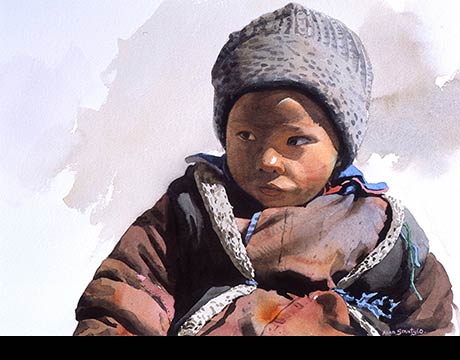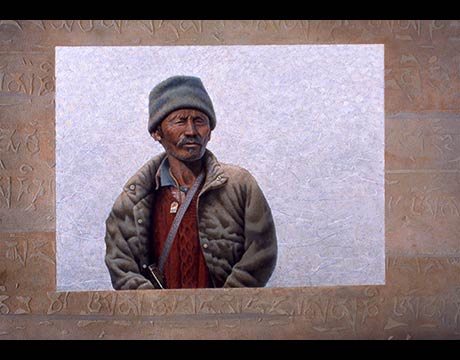Gallery - Past Exhibitions - 2002 - Ladakh
(Click image for slideshow)
Ladakh, deep in the Himalayas of eastern Kashmir, is a land both barren and beautiful, mediaeval and mystical. A realm beyond the clouds: of prayer wheels and monks, of dung fires and yaks, of monasteries clinging like wasp nests to mountain faces and of snow leopards illusive as smoke. In the fall, I returned to this area, to draw and paint in two remote villages, which I had seen the summer before. (Zanskar 2001)
Although inhabited predominately by Buddhists, with it's culture heavily Tibetan, Ladakh is in the state of Jammu-Kashmir in northern India. And hence attached to the Hindu-Muslim itch over which Indian and Pakistan scratch. Aspirations of independence from Muslim elements in Kashmir have been the source of three wars between India and Pakistan in the last 50 years. Another one appeared ominously near.
After four days trekking, I arrived at my first destination, the tiny village of Photaskar. It's tightly grouped houses were perched on the very edge of the Yapola River's deep gorge that carries glacial melt east to the mighty Indus River. Trying to coax grain out of the ground at 15,000 feet, were a string of orbital terraced fields that ringed the top of both sides of the gorge. Behind the village a massive fan of ochre rock, swirled with mocha striations, soared up a thousand feet. This huge granite face was mirrored by an even bigger twin monolith directly across the river canyon. Both were dwarfed by the backdrop of a snow laced mountain wall that folded up into the clouds along the east side of the divide. Nestled in the middle of the brooding giants, the dozen or so tiny worn white-washed dwellings of Photaskar twinkled and humbly sat. The scene was breathtaking.
The Tibetan Buddhists lived and acted as their ancestors before. As the rest of the world embraces societal change like an opiate, attitudes between the generations in Ladakh appeared seamless. Younger people understood they would continue on in life, precisely in their parents' and grandparents' foot steps.
Their religion played a major role in how they viewed life. It emphasised a path to fulfillment and happiness that comes from within, and not predicated on the accumulation of material things. Thinking of others, and not focusing on one's self were instilled at an early age. Violence against each other was unheard of. They had little and required little. At 15,000 ft, they even used half the oxygen of the rest of us.
My second destination was the Lingshed monastery, another two days trek, which included the heart pounding, air sucking climb of the mighty 16,500 ft. Sengi La.
Walking inside the walls of the Lingshed monastery I felt like I was witnessing a feudal play or going back in time to a place my imagination couldn't conceive. Deep guttural chanting, punctuated by the rumble of a goat skin drum, the soprano prayers of a child lama, the call to assemble from a solo conch shell, and sound of hand symbols and silver bells move through the dark warped passage ways of earth and stone...the smell of burning incense...juniper mingled with the smoke of animal dung...doors that swung on wooden hinges and opened with wooden keys...dozens of prayer wheels spun by the worn hands of a thousand monks, a million times...bronze plated statues of Buddha lit by a tiny darkened window and a hundred oil candles...walls of loose-leaf prayer books wrapped in sacred coloured cloth...grotesque skeletal heads of animals, tied with amulets...the unvacuumed dust of five centuries - on the ground and in the air.
invisible
Elevations Unchanged opens May 17, 2003, at Circle Arts, Tobermory, Ontario, Canada.
:: BACK TO GALLERY






